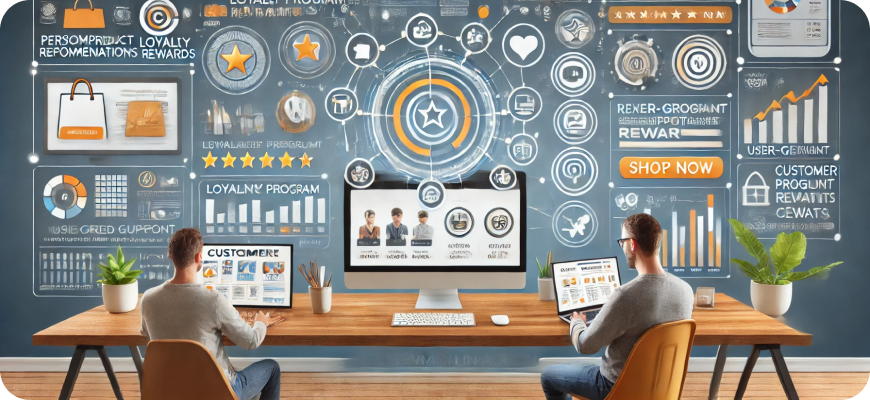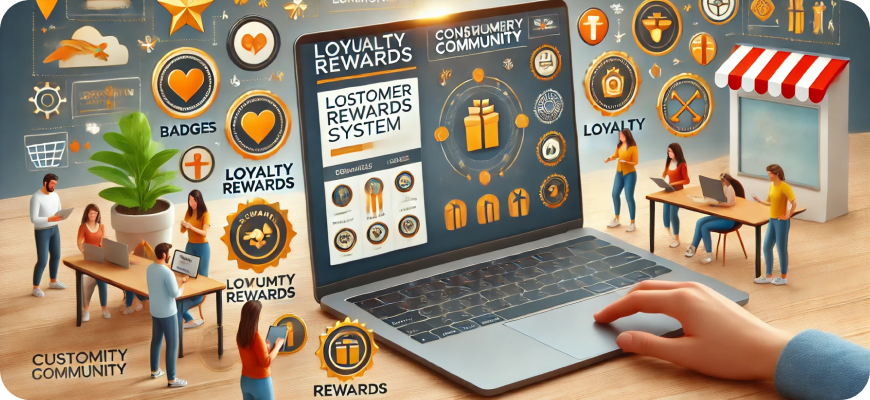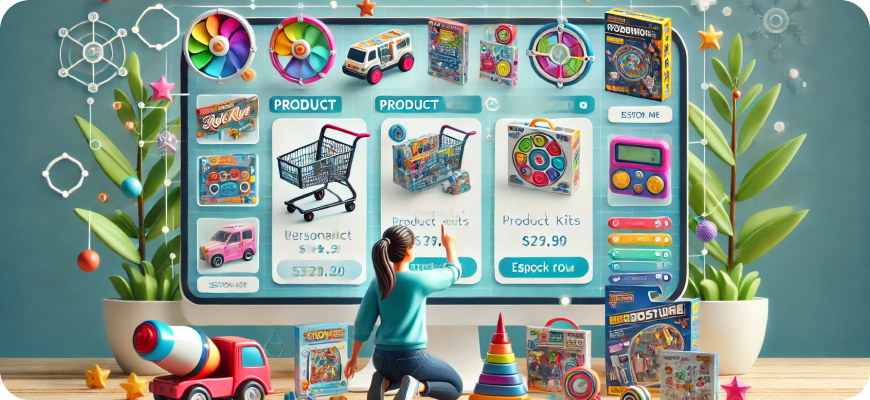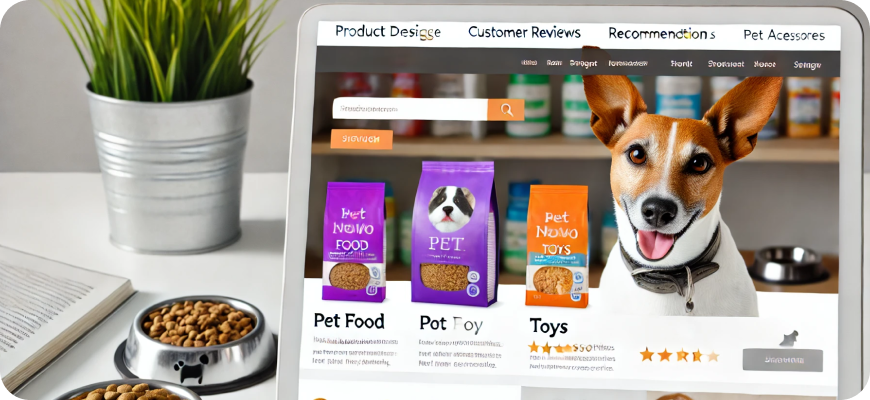Customer Retention Strategies Your Ecommerce Brand Should Use in 2025
In the competitive landscape of ecommerce, customer acquisition is crucial, but customer retention is where long-term profitability lies. With acquisition costs rising, focusing on retaining customers not only improves customer lifetime value but also enhances brand loyalty and advocacy. In 2025, as customer expectations evolve, ecommerce brands will need to implement sophisticated, customer-centric retention strategies to stay relevant. This article explores effective customer retention strategies tailored for the ecommerce landscape in 2025, from leveraging AI-driven personalization to fostering community engagement.

1. Hyper-Personalized Experiences
Personalization is a well-known strategy for improving customer retention, but in 2025, it will reach a new level. Hyper-personalization leverages AI and machine learning to tailor every customer touchpoint based on detailed insights from purchase history, browsing behavior, and customer preferences.
How to Implement Hyper-Personalization:
- AI-Driven Product Recommendations: Use AI to provide real-time product suggestions that align with customers’ preferences and shopping behaviors. For instance, if a customer has recently purchased skincare items, offer them complementary products within the same category.
- Dynamic Content on Websites: Implement dynamic content that changes based on user behavior, location, or past purchases, creating a customized shopping experience for each visit.
- Personalized Email Campaigns: Go beyond simple name personalization. Segment customers into micro-groups and send emails that cater specifically to their needs, such as restock reminders, product care tips, or birthday discounts.
Hyper-personalized experiences make customers feel valued, improving their likelihood of returning to your store.
2. Loyalty Programs with Flexible Rewards
Traditional loyalty programs can feel stagnant, but loyalty programs that offer flexibility and variety are far more effective. In 2025, ecommerce brands should consider loyalty programs that provide customers with choices in their rewards and give them opportunities to earn points across various channels.
Components of an Effective Loyalty Program:
- Point-Based Rewards with Options: Allow customers to earn points for every dollar spent, but also give them choices in redeeming points, such as discounts, freebies, or charitable donations.
- Tiered Rewards Systems: Create multiple reward tiers that incentivize higher spending. For example, Bronze, Silver, and Gold levels, where each tier offers increasingly valuable rewards.
- Gamification Elements: Integrate gamification to make earning rewards fun. Offer badges, challenges, and bonus point days to keep customers engaged and motivated to return.
A flexible loyalty program that customers can tailor to their preferences will enhance their connection to your brand.
3. Seamless Omnichannel Shopping Experience
Consumers in 2025 expect a consistent experience across every channel they interact with, whether online, in-app, or in-store. Creating a seamless omnichannel shopping experience ensures that customers can transition smoothly between different platforms and channels, improving retention.
How to Create a Seamless Omnichannel Experience:
- Unified Cart and Wishlist: Enable customers to add items to their cart or wishlist on one platform (e.g., mobile) and access them later on another (e.g., desktop).
- Consistent Branding and Messaging: Ensure that your brand’s voice, visuals, and messaging are consistent across all channels, from social media to your website and email.
- Integrated Customer Service: Provide support across multiple channels, such as live chat, social media, and phone, and make it possible for customers to pick up where they left off regardless of the platform.
By removing friction from the shopping journey, you encourage repeat visits and purchases, which are crucial for customer retention.
4. Subscription Models and Auto-Replenishment
Subscription models have proven to be a powerful way to retain customers. By offering subscriptions or auto-replenishment options, ecommerce brands can ensure customers return automatically, strengthening long-term retention.
Effective Subscription Strategies:
- Product Subscription Services: Offer product subscriptions for items customers need regularly, such as skincare, supplements, or household essentials.
- Discounted Auto-Replenishment: Provide a small discount for customers who sign up for auto-replenishment, ensuring they never run out of their favorite products.
- Exclusive Subscriber Perks: Create a sense of exclusivity with perks for subscribers, like early access to sales, free shipping, or surprise gifts.
Subscription models create a convenient shopping experience, making it more likely customers will stick with your brand over competitors.
5. Exceptional Customer Support and Self-Service Options
Customer support can make or break the customer experience, particularly if they face issues with their order or have questions about a product. In 2025, ecommerce brands should focus on both high-quality human support and robust self-service options.
Tips for Exceptional Customer Support:
- AI-Powered Chatbots for Instant Help: Use AI chatbots that can handle common questions and route more complex inquiries to human agents.
- Self-Service Knowledge Base: Build a comprehensive knowledge base with FAQs, product guides, and troubleshooting tips so customers can find answers on their own.
- Proactive Follow-Ups: After resolving a customer inquiry, follow up with them to ensure they are satisfied and offer additional assistance if needed.
Providing helpful, accessible customer support improves satisfaction, making customers more likely to return and shop with your brand.
6. Sustainable and Ethical Practices
Sustainability and ethical sourcing are increasingly important to customers, and by 2025, they will be expected elements of brand loyalty. Brands that prioritize eco-friendly practices are likely to retain customers who value sustainability and ethical production.
How to Implement Sustainable Practices:
- Eco-Friendly Packaging: Use biodegradable, recyclable, or reusable packaging materials to reduce your environmental footprint.
- Transparent Sourcing: Clearly communicate where and how products are made, including fair labor practices and responsible sourcing.
- Sustainable Incentives: Encourage sustainable behavior by offering incentives, such as discounts for using minimal packaging or for bringing reusable bags in-store.
Making sustainable choices a part of your brand values will attract customers who are committed to ethical consumption, enhancing retention.
7. Data-Driven Retention Marketing
By using data analytics to understand customer behavior, brands can target retention marketing efforts to keep customers engaged. In 2025, data-driven insights will become more accessible, allowing even smaller brands to benefit.

How to Use Data-Driven Retention Marketing:
- Identify At-Risk Customers: Use predictive analytics to find customers who may be at risk of churning and target them with re-engagement campaigns.
- Send Timely Re-Engagement Emails: Set up automated campaigns to reach out to customers who haven’t purchased recently, using special offers or reminders.
- Personalized Win-Back Campaigns: When customers stop engaging, send personalized emails or messages with incentives to re-engage, such as special discounts or recommended products.
With data-driven marketing, you can engage customers with highly relevant offers and content, increasing their likelihood of returning.
8. Community Building and Social Commerce
Building a brand community can foster a sense of belonging and loyalty among customers, while social commerce offers a more interactive and social shopping experience.
Community-Building Tactics:
- Exclusive Online Communities: Create a members-only space where customers can interact with each other and your brand, such as a Facebook group or a Discord server.
- User-Generated Content (UGC): Encourage customers to share photos, reviews, and experiences with your products on social media, then highlight this content on your website.
- Virtual Events and Livestreams: Host online events, like product launches, Q&A sessions, and how-to workshops, that help customers feel connected to your brand.
A sense of community makes customers feel more connected and engaged, fostering brand loyalty and reducing churn.
9. Flexible Returns and Exchanges
Flexible and hassle-free return policies improve the overall shopping experience and make customers more confident in making repeat purchases.
Best Practices for Flexible Returns:
- Easy, No-Questions-Asked Returns: Simplify the return process with clear guidelines and a no-questions-asked policy.
- Extended Return Windows: Offer longer return windows, especially during holiday seasons or special events.
- Free Return Shipping: Cover return shipping costs for customers, or offer store credits for returns to keep customers loyal to your brand.
A flexible return policy signals that your brand prioritizes customer satisfaction, which helps increase loyalty and retention.
10. Enhanced Post-Purchase Experience
The customer journey doesn’t end at the point of purchase. A strong post-purchase experience makes customers feel valued and encourages them to return.
Post-Purchase Experience Strategies:
- Order Confirmation and Shipping Updates: Keep customers informed with timely updates on order status, estimated delivery dates, and any changes.
- Personalized Thank You Notes: Send a personalized thank-you email or a small note with the package to show appreciation.
- Feedback Requests and Product Care Tips: Ask for feedback post-purchase and offer tips on how to use and care for the product to enhance customer satisfaction.
Enhancing the post-purchase experience ensures that customers feel appreciated, leading to greater loyalty and repeat business.
11. Real-Time Customer Feedback and Iteration
Customer expectations and preferences are always changing. Gathering real-time feedback allows brands to quickly adjust and improve.
How to Gather and Use Feedback:
- Post-Purchase Surveys: Send quick surveys after each purchase to learn about the customer’s experience and any issues they encountered.
- Monitor Social Media: Track brand mentions and engage with customers who share feedback or complaints on social platforms.
- Implement Changes Quickly: When you receive feedback about improvements, act quickly and let customers know their feedback was heard.
Responsive feedback loops build trust, and customers are more likely to stay loyal to a brand that listens and adapts.
12. Implement Predictive Analytics for Customer Retention
Using predictive analytics, brands can forecast customer behaviors and anticipate retention needs. Predictive models analyze customer data to identify trends, allowing you to proactively target customers likely to churn.
Steps to Implement Predictive Analytics:
- Gather and Analyze Customer Data: Collect data on purchase frequency, average order value, browsing habits, and engagement.
- Develop Churn Prediction Models: Use machine learning algorithms to identify customers likely to churn based on behavioral patterns.
- Design Targeted Retention Campaigns: Use insights from the predictive model to create retention campaigns that address specific customer needs.
By anticipating when customers may churn, you can take action to retain them and improve long-term loyalty.

Conclusion
In 2025, the most successful ecommerce brands will be those that prioritize customer retention and create meaningful, long-lasting relationships with their customers. By implementing hyper-personalization, building strong loyalty programs, enhancing customer support, and embracing sustainability, you can foster a sense of loyalty and trust with your customers. Embrace these strategies to not only retain your customers but also turn them into brand advocates who will support and promote your brand in the years to come.






